Syntheses, Structures, and Properties of Mono- and Dinuclear Acetylacetonato Ruthenium(III) Complexes with Chlorido or Thiocyanato Ligands
Abstract
:1. Introduction
2. Results and Discussion
2.1. Synthesis and Characterizations
2.2. Crystal Structures
2.3. Magnetic Properties
2.4. Reflectance and Absorption Spectra
2.5. 1H NMR Spectra
2.6. Cyclic Voltammograms
3. Materials and Methods
3.1. General Aspects
3.2. Synthesis of Complexes
3.2.1. Synthesis of trans-Ph4P[RuIII(acac)2Cl2] (1)
3.2.2. Synthesis of Ph4P[{RuIII(acac)Cl}2(μ-Cl)3] (2)
3.2.3. Synthesis of trans-Ph4P[RuIII(acac)2(NCS)2] (3·0.5C6H14)
3.3. Crystal Structure Determination
4. Conclusions
Supplementary Materials
Author Contributions
Funding
Institutional Review Board Statement
Informed Consent Statement
Data Availability Statement
Acknowledgments
Conflicts of Interest
References
- Chen, G.J.-J.; McDonald, J.W.; Newton, W.E. Preparation of OMoCl(acac)2 by a novel oxygen-chlorine atom exchange and its use as a reagent for the synthesis of monomeric molybdenum(V) complexes. Inorg. Chim. Acta 1979, 35, 93–97. [Google Scholar] [CrossRef]
- Doyle, G. The Reaction of Some Molybdenum and Tungsten Halides with β-Diketones. Inorg. Chem. 1971, 10, 2348–2350. [Google Scholar] [CrossRef]
- Dallmann, K.; Preetz, W. Crystal Structures, Vibrational Spectra and Normal Coordinate Analyses of cis- and trans-[OsX2(acac)2], X = Cl, Br, I. Z. Für Naturforschung B 1997, 52, 965–974. [Google Scholar] [CrossRef]
- Young, K.J.H.; Mironov, O.A.; Nielsen, R.J.; Chen, M.J.; Stewart, T.; Goddard, W.A., III; Periana, R.A. Synthesis and Characterization of the κ2-acac-O,O Complex OsIV(acac)2PhCl and Study of CH Activation with Benzene. Organometallics 2011, 30, 5088–5094. [Google Scholar] [CrossRef]
- Ferguson, G.; Glidewell, C. Enantiomeric disorder in racemic cis dichlorobis(pentane-2,4-dionato) titanium(IV). Acta Cryst. 2001, C57, 264–265. [Google Scholar]
- Wilkie, C.A.; Lin, G.Y.; Haworth, D.T. A comparative study of the cis-disubstituted bis(β-diketonato)titanium(IV) complexes. J. Inorg. Nucl. Chem. 1978, 40, 1009–1012. [Google Scholar] [CrossRef]
- Lindmark, A.F.; Fay, R.C. Dipseudohalobis (β-diketonato)titanium(IV) complexes. Synthesis, stereochemistry, configurational rearrangements, and vibrational spectra. Inorg. Chem. 1975, 14, 282–287. [Google Scholar] [CrossRef]
- Bradley, D.C.; Holloway, C.E. Nuclear magnetic resonance and infrared spectral studies on labile cis-dialkoxy-bis(acetylacetonato)titanium(IV) compounds. J. Chem. Soc. A 1969, 282–285. [Google Scholar] [CrossRef]
- Brown, S.N.; Chu, E.T.; Hull, M.W.; Noll, B.C. Electronic Dissymmetry in Chiral Recognition. J. Am. Chem. Soc. 2005, 127, 16010–16011. [Google Scholar] [CrossRef] [PubMed]
- Fay, R.C.; Lowry, R.N. Structure and lability of dihalobis(acetylacetonato)titanium(IV) complexes. Inorg. Nucl. Chem. Lett. 1967, 3, 117–120. [Google Scholar] [CrossRef]
- Cox, M.; Clark, R.J.H.; Milledge, H.J. Structural Studies on Group IV Metal Acetylacetonates. Nature 1966, 212, 1357. [Google Scholar] [CrossRef]
- Sarkhel, P.; Paul, B.C.; Poddar, R.K. Rhodium(III) complexes containing acetylacetonate and mono- or bidentate ligands. Indian J. Chem. 1999, 38A, 150–155. [Google Scholar]
- Sodhi, R.K.; Paul, S. An Overview of Metal Acetylacetonates: Developing Areas/Routes to New Materials and Applications in Organic Syntheses. Catal. Surv. Asia 2018, 22, 31–62. [Google Scholar] [CrossRef]
- Behzadi, K.; Thompson, A. Preparation, Characterization and Reactions of Vanadium(IV) β-Diketonate Complexes. J. Less Common Met. 1987, 128, 281–296. [Google Scholar] [CrossRef]
- Paul, B.C.; Poddar, R.K. Synthesis, characterization and reactivity studies of dichloroacetylacetonato acetylacetone ruthenium(III). Transit. Met. Chem. 1993, 18, 96–100. [Google Scholar] [CrossRef]
- Janiak, C.; Scharmann, T.G.; Lange, C.H.K. Zirconium β-diketonate/methylaluminoxane systems as singlesite catalysts for the preparation of high-molecular-weight polyethylene. Macromol. Rapid Commun. 1994, 15, 655–658. [Google Scholar] [CrossRef]
- Pinnavia, T.J.; Fay, R.C. Preparation and properties of some six- and seven-coordinate halo(acetylacetonato) complexes of zirconium(IV) and hafnium(IV). Inorg. Chem. 1968, 7, 502–508. [Google Scholar] [CrossRef]
- Bagnall, K.W.; Edwards, J.; Rickard, C.E.F.; Tempest, A.C. Cyclopentadienyluranium(IV) acetylacetonates. J. Inorg. Nucl. Chem. 1979, 41, 1321–1323. [Google Scholar] [CrossRef]
- Shibata, S.; Ohta, M. Molecular structure of bis(acetylacetonato)zinc(II) in the gas phase as determined from electron diffraction data. J. Mol. Struct. 1981, 77, 265–270. [Google Scholar] [CrossRef]
- Korochentsev, V.V.; Vovna, V.I.; L’vov, I.B.; Shapkin, N.P. Electronic and geometric structure of the protonated forms of nickel β-diketonates. Russ. J. Coord. Chem. 2011, 37, 371–376. [Google Scholar] [CrossRef]
- Funaioli, T.; Marchetti, F.; Pampaloni, G.; Zacchini, S. Ligand-interchange reactions between M(iv) (M = Ti, V) oxide bis-acetylacetonates and halides of high-valent group 4 and 5 metals. A synthetic and electrochemical study. Dalton Trans. 2013, 42, 14168–14177. [Google Scholar] [CrossRef]
- Stabinikov, P.A.; Pervukhina, N.V.; Baidina, I.A.; Sheludyakova, L.A.; Borisov, S.V. On the Symmetry of iron(III) tris-acetylacetonate crystals. J. Struct. Chem. 2007, 48, 186–192. [Google Scholar] [CrossRef]
- Shalhoub, G.M. Co(acac)3 Synthesis, reactions, and spectra: An experiment for general chemistry. J. Chem. Educ. 1980, 57, 525–526. [Google Scholar] [CrossRef]
- Ledneva, A.Y.; Artemkina, S.B.; Piryazev, D.A.; Fedorov, V.E. Structure and Thermal Properties of the molybdenum Complex Mo(acac)3. J. Struct. Chem. 2015, 56, 1021–1023. [Google Scholar] [CrossRef]
- Dedeian, K.; Djurovich, P.I.; Garces, F.O.; Carlson, G.; Watts, R.J. A new synthetic route to the preparation of a series of strong photoreducing agents: Fac-tris-ortho-metalated complexes of iridium(III) with substituted 2-phenylpyridines. Inorg. Chem. 1991, 30, 1685–1687. [Google Scholar] [CrossRef]
- Dallmann, K.; Preetz, W. Darstellung, Kristallstruktur, Schwingungsspektren und Normalkoordinatenanalyse von [Os(acac)3]/ Synthesis, Crystal Structure, Vibrational Spectra, and Normal Coordinate Analysis of [Os(acac)3]. Z. Für Naturforschung B 1998, 53, 232–238. [Google Scholar] [CrossRef]
- Jackson, A.B.; White, P.S.; Templeton, J.L. Bis(acetylacetonato)tricarbonyl Tungsten(II): A Convenient Precursor to Chiral Bis(acac) Tungsten(II) Complexes. Inorg. Chem. 2006, 45, 6205–6213. [Google Scholar] [CrossRef] [PubMed]
- Chang, Q.; Yan, C.; Li, X.-N.; Cui, H.; Ye, Q.; Jiang, J.; Yu, J.; Chen, J.; Liu, W. The influence of sodium and barium ions on the structures of iridium (III) acetylacetonate complexes. Res. Chem. Intermed. 2015, 41, 7631–7640. [Google Scholar] [CrossRef]
- Nakanishi, R.; Yatoo, M.A.; Katoh, K.; Breedlove, B.K.; Yamashita, M. Dysprosium Acetylacetonato Single-Molecule Magnet Encapsulated in Carbon Nanotubes. Materials 2017, 10, 7. [Google Scholar] [CrossRef]
- Zhang, D.; Zhang, L.-F.; Yuting, C.; Hailong, W.; Ni, Z.-H.; Wolfgang, W.; Jianzhuang, J. Heterobimetallic porphyrin-based single-chain magnet constructed from manganese(iii)-porphyrin and trans-dicyanobis(acetylacetonato) ruthenate(iii) containing co-crystallized bulk anions and cations. Chem. Commun. 2010, 46, 3550–3552. [Google Scholar] [CrossRef]
- Lan, W.; Hao, X.; Dou, Y.; Zhou, Z.; Yang, L.; Liu, H.; Li, D.; Dong, Y.; Kong, L.; Zhang, D. Various Structural Types of Cyanide-Bridged FeIII–MnIII Bimetallic Coordination Polymers (CPs) and Polynuclear Clusters Based-on A New mer-Tricyanoiron(III)Building Block: Synthesis, Crystal Structures, and Magnetic Properties. Polymers 2019, 11, 1585. [Google Scholar] [CrossRef]
- Hirayama, M.; Kitani, K. Observation of 27Al n.m.r. paramagnetic shifts (large contact shift contributions) induced by lanthanoid shift-reagents in tris(acetylacetonato)aluminium(III). J. Chem. Soc. Chem. Commun. 1980, 21, 1030–1031. [Google Scholar] [CrossRef]
- Goff, H.M.; Hines, J.; Griesel, J.; Mossman, C. Synthesis, Characterization, and Use of a Cobalt(II) Complex as an NMR Shift Reagent. J. Chem. Educ. 1982, 59, 422–423. [Google Scholar] [CrossRef]
- Levy, G.C.; Komoroski, R.A. Paramagnetic Relaxation Reagents. Alternatives or Complements to Lanthanide Shift Reagents in Nuclear Magnetic Resonance Spectral Analysis. J. Am. Chem. Soc. 1974, 96, 678–681. [Google Scholar] [CrossRef]
- Gillies, E.; Szarek, W.A.; Baird, M.C. Application of Paramagnetic Shift Reagents in Nuclear Magnetic Resonance Studies of Complex Alcohols and Amines. Can. J. Chem. 1971, 49, 211–216. [Google Scholar] [CrossRef]
- Sirkecioglu, O.; Karliga, B.; Talinli, N. Benzylation of alcohols by using bis[acetylacetonato]copper as catalyst. Tetrahedron Lett. 2003, 44, 8483–8485. [Google Scholar] [CrossRef]
- Pichugina, D.; Kuz’menko, N.; Shestakov, A. Gold complexes with Oxygen-containing Ligands as a Catalyst for Methane Oxidation. Gold Bull. 2007, 40, 115–120. [Google Scholar] [CrossRef]
- Yeung, W.-F.; Man, W.-L.; Wong, W.-T.; Lau, T.-C.; Gao, S. Ferromagnetic Ordering in a Diamond-Like Cyano-Bridged MnIIRuIII Bimetallic Coordination Polymer. Angew. Chem. Int. Ed. 2001, 40, 3031–3033. [Google Scholar] [CrossRef]
- Guo, J.-F.; Wang, X.-T.; Wang, B.-W.; Xu, G.-C.; Gao, S.; Szeto, L.; Wong, W.-T.; Wong, W.-Y.; Lau, T.-C. One-Dimensional Ferromagnetically Coupled Bimetallic Chains Constructed with trans-[Ru(acac)2(CN)2]−: Syntheses, Structures, Magnetic Properties, and Density Functional Theoretical Study. Chem. Eur. J. 2010, 16, 3524–3535. [Google Scholar] [CrossRef]
- Hasegawa, T.; Lau, T.C.; Taube, H.; Schaefer, W.P. Electronic Effects of Bis(acetylacetone) in Ruthenium(II) and Ruthenium(III) Complexes. Inorg. Chem. 1991, 30, 2921–2928. [Google Scholar] [CrossRef]
- Darriet, J. Crystal structure and magnetic properties of the (Ru2Cl9)3− ion in Cs3Ru2Cl9. Rev. Chim. Mine. 1981, 18, 27–32. [Google Scholar]
- Hughes, M.N.; O’Reardon, D.; Poole, R.K.; Hursthouse, M.B.; Thornton-Pett, M. The Structure of the mixed-valence chloro-bridged dimeric complex cation [Ru2(NH3)6Cl3]2+. Polyhedron 1987, 6, 1711–1713. [Google Scholar] [CrossRef]
- Clucas, W.A.; Armstrong, R.S.; Buys, I.E.; Hambley, T.W.; Nugent, K.W. X-ray Crystallographic Study of the Ruthenium Blue Complexes [Ru2Cl3(tacn)2](PF6)2·H2O, [Ru2Br3(tacn)2](PF6)2·2H2O, and [Ru2I3(tacn)2](PF6)2: Steric Interactions and the Ru-Ru “Bond Length”. Inorg. Chem. 1996, 35, 6789–6794. [Google Scholar] [CrossRef] [PubMed]
- Neubold, P.; Vedova, B.S.P.C.D.; Wieghardt, K.; Nuber, B.; Weiss, J. Novel Cofacial Bioctahedral Complexes of Ruthenium: Syntheses and Properties of the Mixed-Valence Species [LRu2.5(μ-X)3Ru2.5L]2+ (X = Cl, Br, I, OH). Crystal Structures of [LRu2.5(μ-OH)3Ru2.5L](PF6)2·H2O and [LRuIV(μ-O)3RuIVL](PF6)2·H2O (L = 1,4,7-Trimethyl-1,4,7-triazacyclononane). Inorg. Chem. 1990, 29, 3355–3363. [Google Scholar]
- Bonner, J.C.; Fisher, M.E. Linear Magnetic Chains with Anisotropic Coupling. Phys. Rev. 1964, 135, 640–658. [Google Scholar] [CrossRef]
- Bleaney, B.; Bowers, K.D. Anomalous paramagnetism of copper acetate. Proc. R. Soc. Lond. 1952, 214, 451–465. [Google Scholar] [CrossRef]
- Lovel, T.; Stranger, R.; McGrady, J.E. Mutal Interdependence of Spin Crossover and Metal-Metal Bond Formation in M2Cl93− (M = Fe, Ru, Os). Inorg. Chem. 2001, 40, 39–43. [Google Scholar] [CrossRef]
- Cotton, F.A.; Matusz, M.; Torralba, R.C. New Di- and Trinuclear Complexes of Ruthenium with Octahedra Joined on Faces or Edges: Ru2Cl6(PBu3)3, Ru2Cl6(PBu3)4 and Ru3Cl8(PBu3)4 (Bu = CH3CH2CH2CH2). Inorg. Chem. 1989, 28, 1516–1520. [Google Scholar] [CrossRef]
- Grobelny, R.; Jezowska-Trzebiatowska, B.; Wojciechowski, W. The Absorption Spectra and Magnetic Properties of the chelated compounds of Ru(III) with β-diketones. J. Inorg. Nucl. Chem. 1966, 28, 2715–2718. [Google Scholar] [CrossRef]
- Cardona, C.M.; Li, W. Electrochemical Considerations for Determining Absolute Frontier Orbital Energy Levels of Conjugated Polymers for Solar Cell Applications. Adv. Mater. 2011, 23, 2367–2371. [Google Scholar] [CrossRef]
- Hashem, E.; Platts, J.A.; Hartl, F.; Lorusso, G.; Evangelisti, M.; Schulzke, C.; Baker, R.J. Thiocyanate Complexes of Uranium in Multiple Oxidation States: A Combined Structural, Magnetic, Spectroscopic, Spectroelectrochemical, and Theoretical Study. Inorg. Chem. 2014, 53, 8624–8637. [Google Scholar] [CrossRef]
- Bain, G.A.; Berry, J.F. Diamagnetic Corrections and Pascal’s Constants. J. Chem. Educ. 2008, 85, 532–536. [Google Scholar] [CrossRef]
- Gottlieb, H.E.; Kotlyar, V.; Nudelman, A. NMR Chemical Shifts of Common Laboratory Solvents as Trace Impurities. J. Org. Chem. 1997, 62, 7512–7515. [Google Scholar] [CrossRef]
- Fulmer, G.R.; Miller, A.J.M.; Sherden, N.H.; Hugo, E.G.; Nudelman, A.; Brian, M.S.; John, E.B.; Karen, I.G. NMR Chemical Shifts of Trace Impurities: Common Laboratory Solvents, Organics, and Gases in Deuterated Solvents Relevant to the Organometallic Chemist. Organometallics 2010, 29, 2176–2179. [Google Scholar] [CrossRef]
- Sheldrick, G.M. SHELXT—Integrated space-group and crystal-structure determination. Acta Cryst. 2015, A71, 3–8. [Google Scholar] [CrossRef] [PubMed]
- Sheldrick, G.M. Crystal structure refinement with SHELXL. Acta Cryst. 2015, C71, 3–8. [Google Scholar]

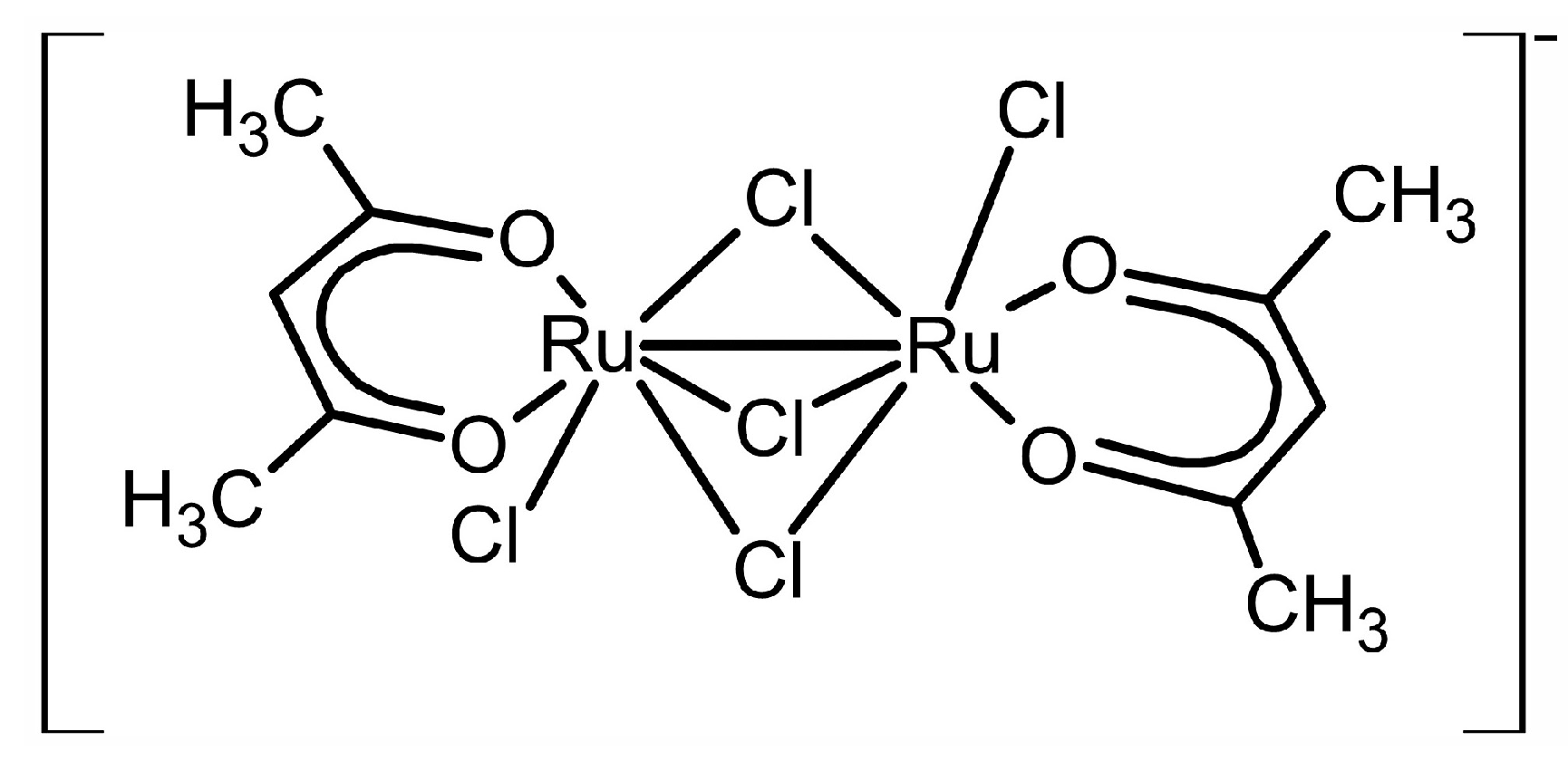
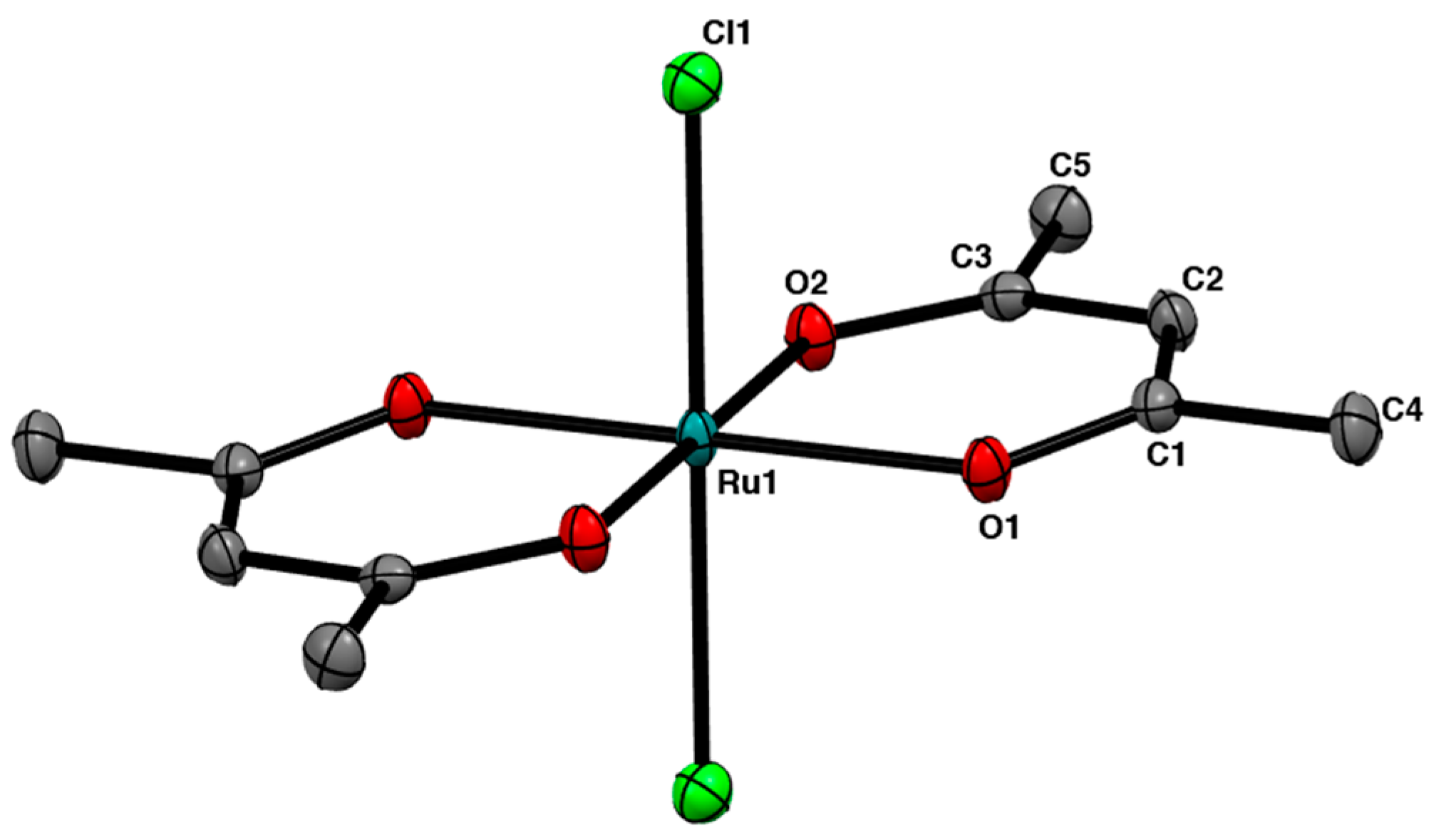
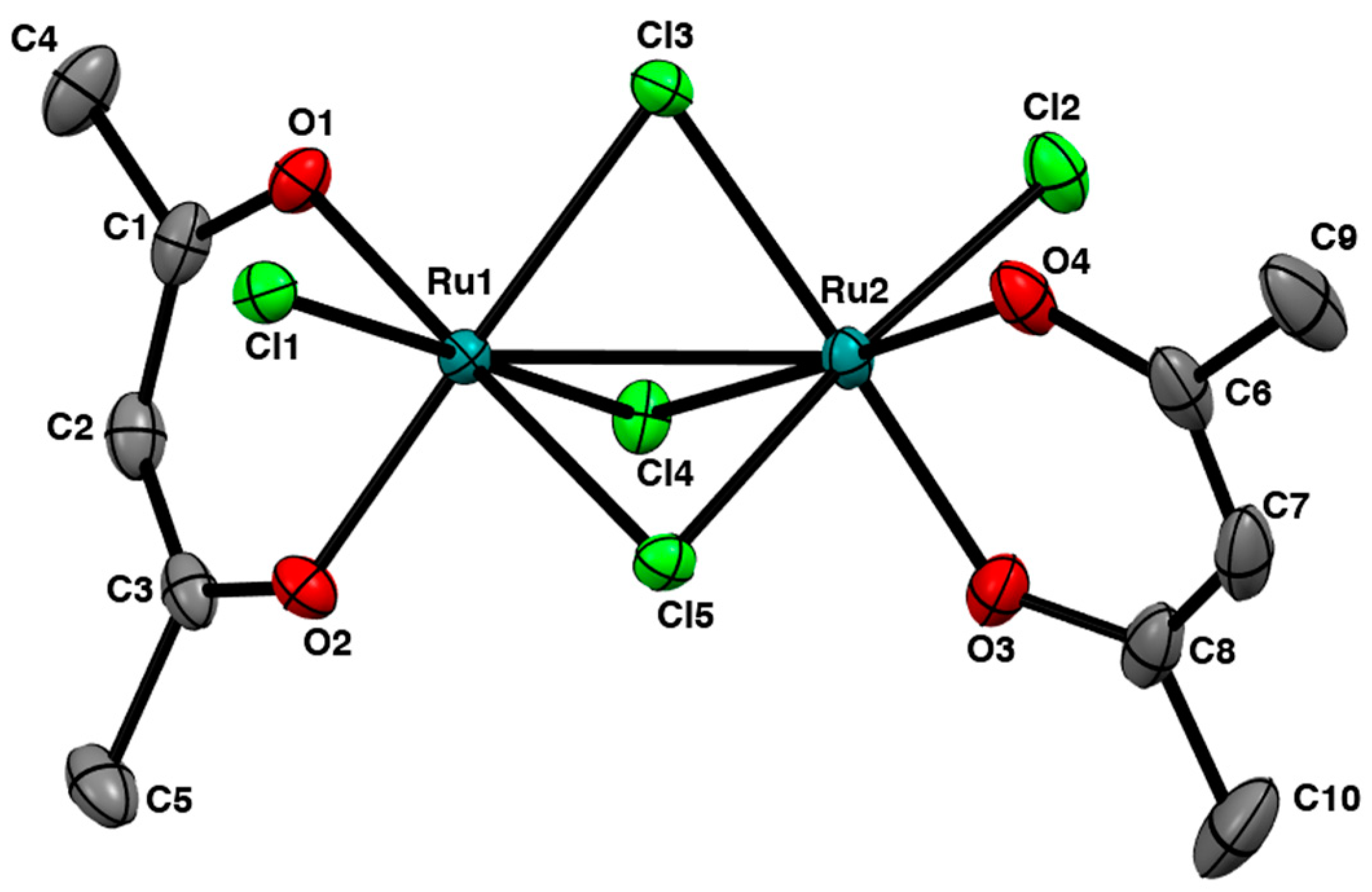


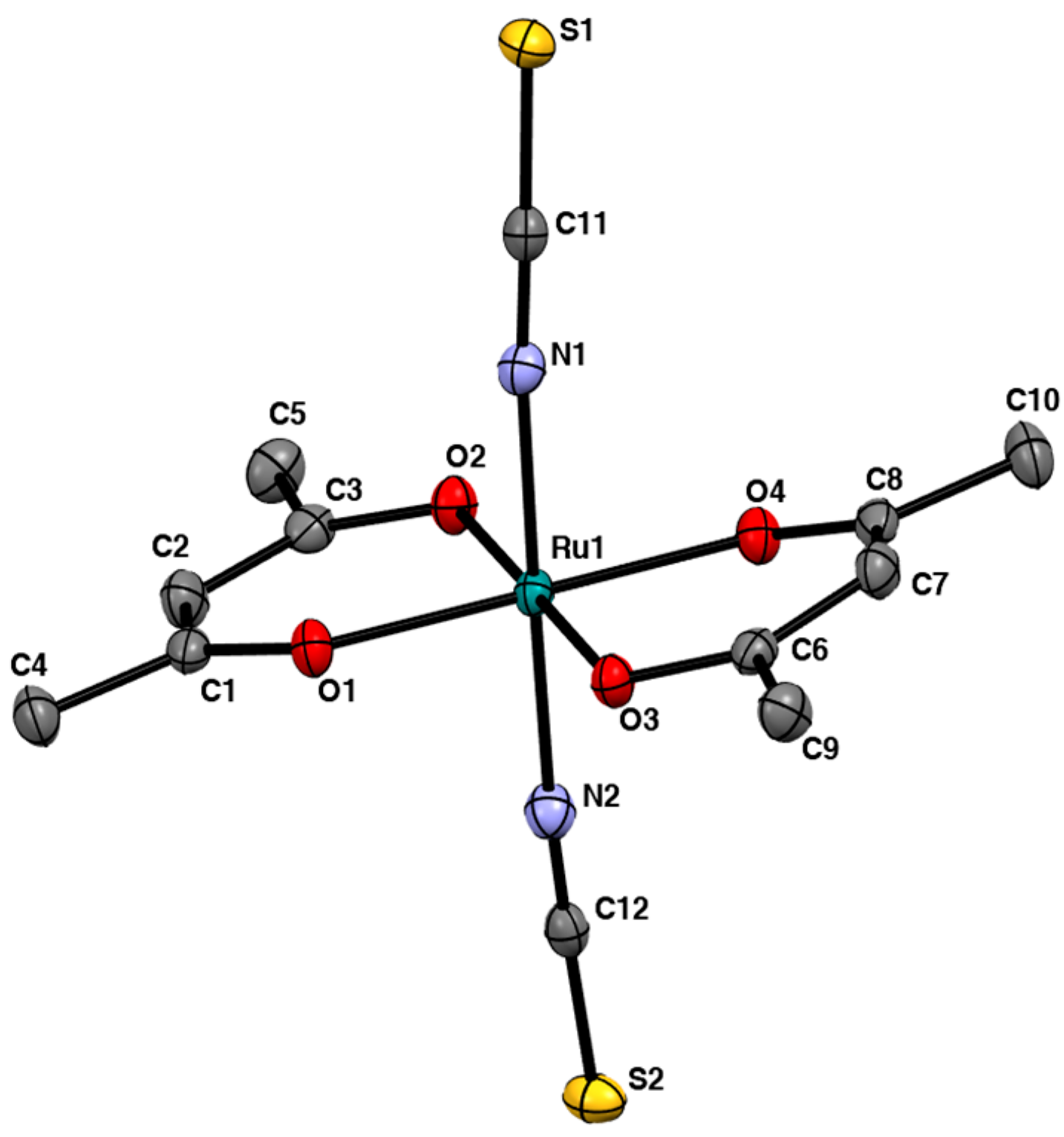


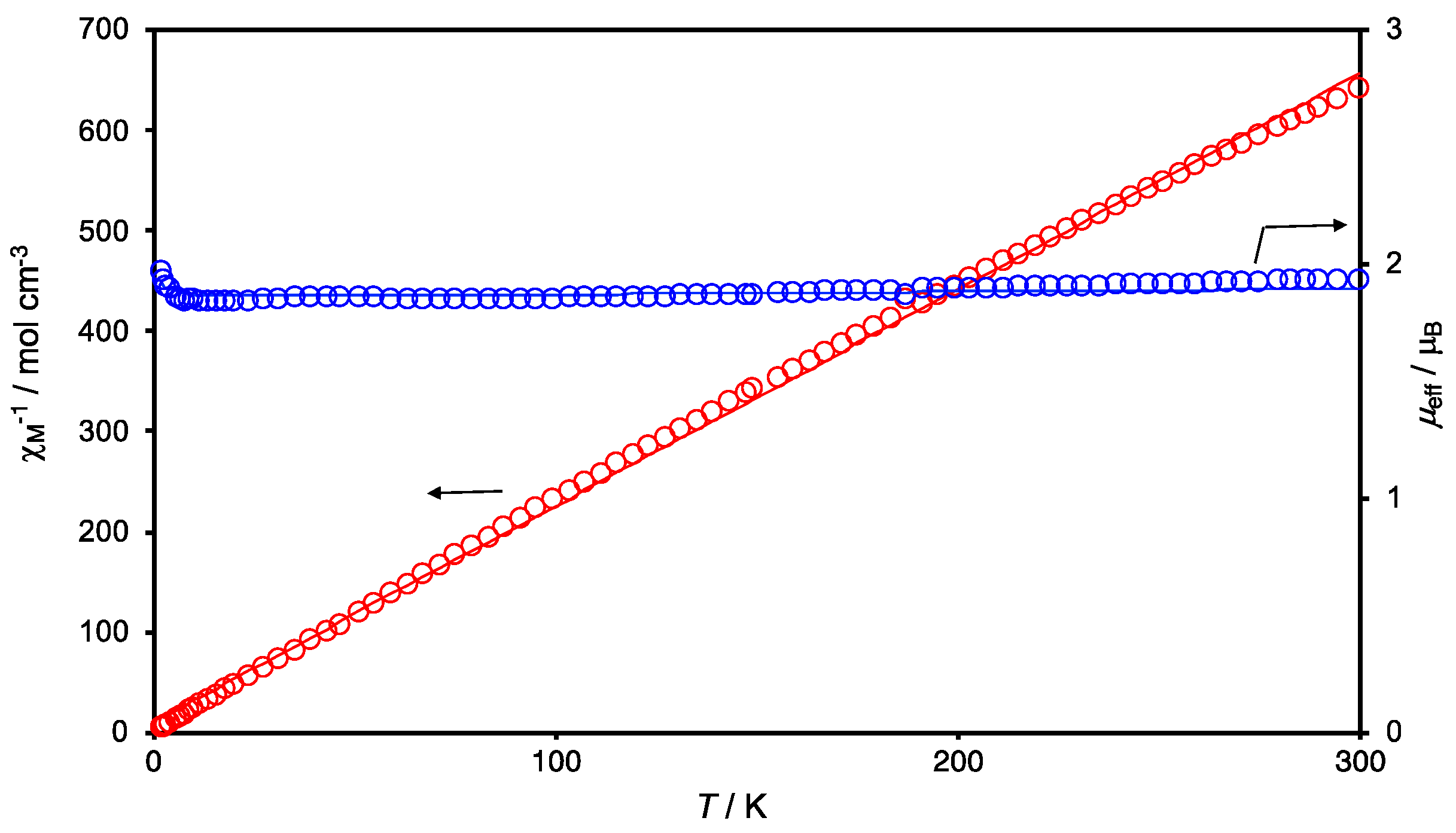



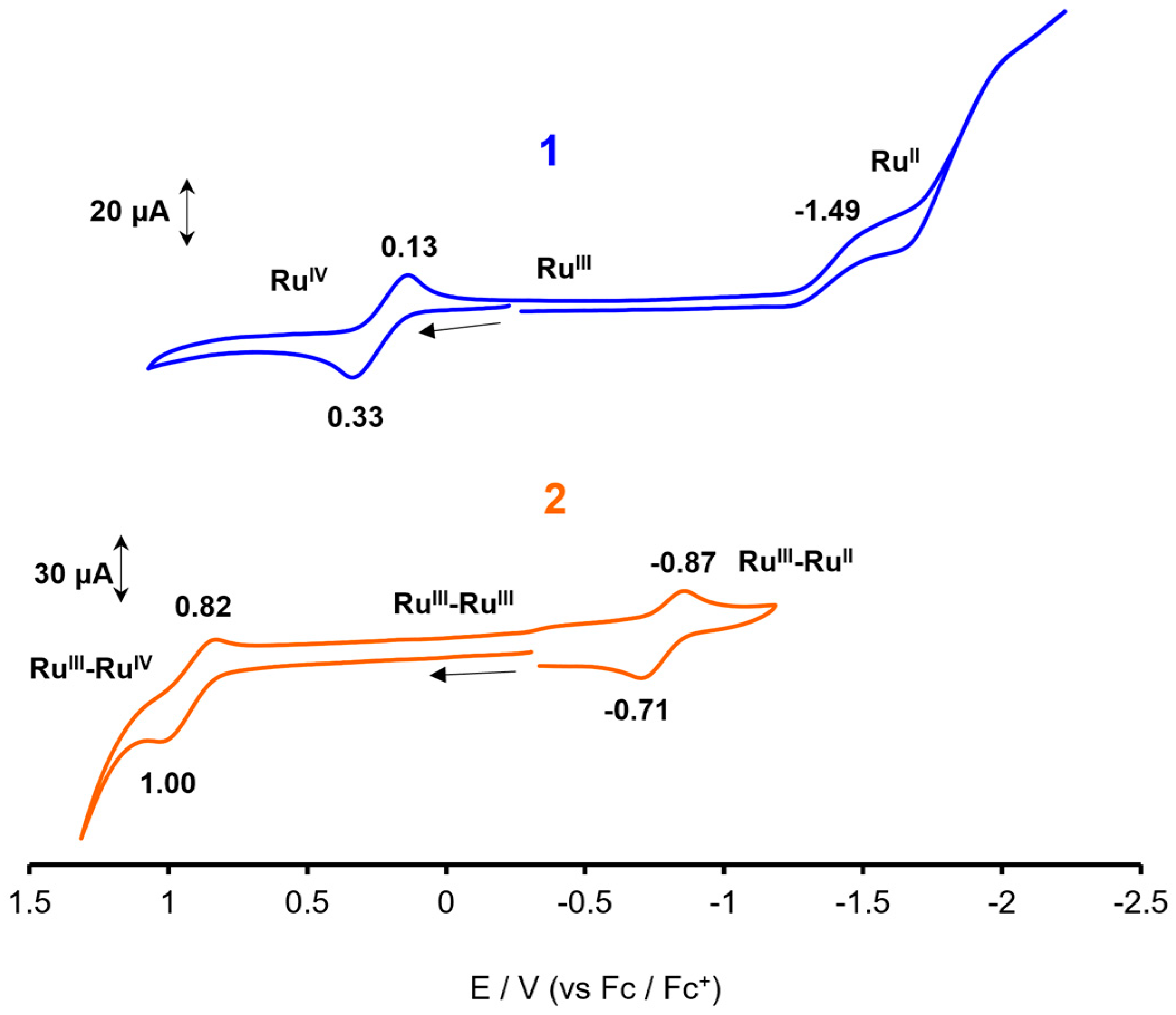

| Complexes | 1 | 2·H2O | 3·CH3CN |
|---|---|---|---|
| Chemical formula | C34H34Cl2O4PRu | C34H36Cl5O5PRu2 | C38H37N3O4PRuS2 |
| FW | 709.55 | 935.03 | 795.87 |
| Temperature, T (K) | 93 | 93 | 93 |
| Crystal system | Triclinic | Triclinic | Monoclinic |
| Space group | P21/n | ||
| a (Å) | 9.8418(2) | 10.91020(10) | 20.0627(3) |
| b (Å) | 13.3562(3) | 12.05510(10) | 7.36340(10) |
| c (Å) | 14.1498(2) | 16.1720(2) | 24.6645(5) |
| α (°) | 103.441(2) | 69.5690(10) | 90 |
| β (°) | 106.783(2) | 74.3220(10) | 98.403(2) |
| γ(°) | 107.998(2) | 70.0890(10) | 90 |
| V (Å3) | 1584.42(6) | 1846.19(4) | 3604.56(10) |
| Z | 2 | 2 | 4 |
| Dcalcd (g cm−3) | 1.487 | 1.678 | 1.478 |
| Crystal size (mm) | 0.2 × 0.1 × 0.05 | 0.15 × 0.1 × 0.05 | 0.2 × 0.1 × 0.05 |
| μ (mm−1) | 0.751 | 1.263 | 0.643 |
| θ range for data collection (°) | 1.607–31.464 | 1.980–31.546 | 1.669–31.629 |
| Reflections collected | 30,580 | 34,229 | 67,229 |
| [R1 (I < 2σ(I)); wR2 (all data)] (a) | R1 = 0.0301 ωR2 = 0.0826 | R1 = 0.0283 ωR2 = 0.0743 | R1 = 0.0310 ωR2 = 0.0947 |
| GOF | 1.106 | 1.072 | 1.099 |
Disclaimer/Publisher’s Note: The statements, opinions and data contained in all publications are solely those of the individual author(s) and contributor(s) and not of MDPI and/or the editor(s). MDPI and/or the editor(s) disclaim responsibility for any injury to people or property resulting from any ideas, methods, instructions or products referred to in the content. |
© 2024 by the authors. Licensee MDPI, Basel, Switzerland. This article is an open access article distributed under the terms and conditions of the Creative Commons Attribution (CC BY) license (https://creativecommons.org/licenses/by/4.0/).
Share and Cite
Nakashima, K.; Hayami, C.; Nakashima, S.; Akashi, H.; Mikuriya, M.; Handa, M. Syntheses, Structures, and Properties of Mono- and Dinuclear Acetylacetonato Ruthenium(III) Complexes with Chlorido or Thiocyanato Ligands. Magnetochemistry 2024, 10, 16. https://doi.org/10.3390/magnetochemistry10030016
Nakashima K, Hayami C, Nakashima S, Akashi H, Mikuriya M, Handa M. Syntheses, Structures, and Properties of Mono- and Dinuclear Acetylacetonato Ruthenium(III) Complexes with Chlorido or Thiocyanato Ligands. Magnetochemistry. 2024; 10(3):16. https://doi.org/10.3390/magnetochemistry10030016
Chicago/Turabian StyleNakashima, Kai, Chihiro Hayami, Shino Nakashima, Haruo Akashi, Masahiro Mikuriya, and Makoto Handa. 2024. "Syntheses, Structures, and Properties of Mono- and Dinuclear Acetylacetonato Ruthenium(III) Complexes with Chlorido or Thiocyanato Ligands" Magnetochemistry 10, no. 3: 16. https://doi.org/10.3390/magnetochemistry10030016
APA StyleNakashima, K., Hayami, C., Nakashima, S., Akashi, H., Mikuriya, M., & Handa, M. (2024). Syntheses, Structures, and Properties of Mono- and Dinuclear Acetylacetonato Ruthenium(III) Complexes with Chlorido or Thiocyanato Ligands. Magnetochemistry, 10(3), 16. https://doi.org/10.3390/magnetochemistry10030016









